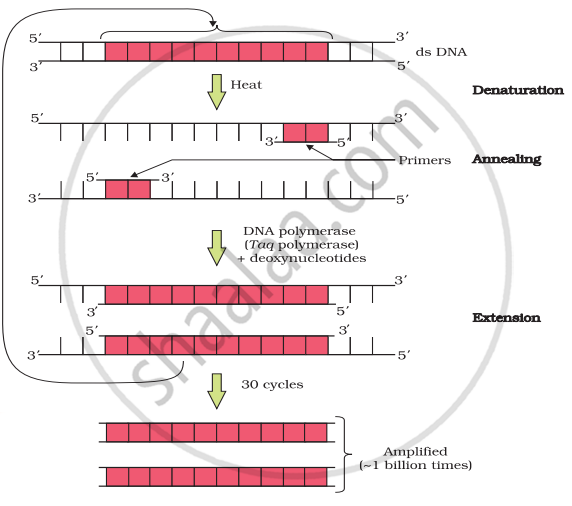Advertisements
Advertisements
प्रश्न
Can you list 10 recombinant proteins which are used in medical practice? Find out where they are used as therapeutics (use the internet).
उत्तर
Recombinant proteins are obtained from the recombinant DNA technology. This technology involves the transfer of specific genes from an organism into another organism using vectors and restriction enzymes as molecular tools.
Ten recombinant proteins used in medical practice are −
| Recombinant protein | Therapeutic use |
| Insulin | Treatment for type I diabetes mellitus |
| Interferon-α | Used for chronic hepatitis C |
| Interferon-α | Used against herpes and viral enteritis |
| Coagulation factor VIII | Treatment of haemophilia A |
| Coagulation factor IX | Treatment of haemophilia B |
| DNAase I | Treatment of cystic fibrosis |
| Anti-thrombin III | Prevention of blood clot |
| Interferon B | For treatment of multiple sclerosis |
| Human recombinant growth hormone | For promoting growth in an individual |
| Tissue plasminogen activator | Treatment of acute myocardial infarction |
APPEARS IN
संबंधित प्रश्न
Draw a labelled sketch of sparged-stirred-tank bioreactor. Write its application.
From what you have learnt, can you tell whether enzymes are bigger or DNA is bigger in molecular size? How did you know?
Explain briefly:
PCR
Explain briefly:
Chitinase
Answer the following question:
Describe the process of amplification of the "gene of interest" using the PCR technique.
DNA fragments generated by the restriction endonuclease in a chemical reaction can be separated by ______.
PCR proceeds mthree distinct steps governed by temperature, they are in order of ______.
The first step in recombinant DNA technology is
In addition to the Taq polymerase enzyme, which other thermostable DNA polymerases have been isolated to be used in PCR?
During the purification process for recombinant DNA technology, the addition of chilled ethanol precipitates out ______.
An antibiotic resistance gene in a vector usually helps in the selection of ______.
Significance of 'heat shock' method in bacterial transformation is to facilitate ______.
Which of the following should be chosen for best yield if one were to produce a recombinant protein in large amounts?
While doing a PCR, ‘denaturation’ step is missed. What will be its effect on the process?
Do biomolecules (DNA, protein) exhibit biological activity in anhydrous conditions?
Identify and explain steps ‘A’, ‘B’ and ‘C’ in the PCR diagram given below.

Read the paragraph given below and answer and questions that follow:
| Enzyme Taq polymerase, is extracted from a eubacterial microorganism Thermus aquaticus from Yellowstone National Park in Montana, USA and isolated by Chien et al. (1976). Taq polymerase successfully replaced the DNA polymerase from E.coli that was being used in PCR earlier and this shift revolutionised the PCR technique. |
- Taq polymerase after its discovery replaced E.coli DNA polymerase in PCR technique. Explain giving reasons why was the need felt for the change?
- What is a primer and its importance in PCR?
- Write the importance of PCR as a diagnostic tool.
State the advantage of using Thermostable DNA polymerase.
